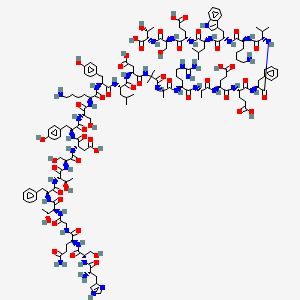



1. Zegalogue
1. 1544300-84-6
2. Dasiglucagon [inn]
3. Dasiglucagon [usan]
4. Dasiglucagon [who-dd]
5. Dasiglucagon [usan:inn]
6. Unii-ad4j2o47fq
7. Ad4j2o47fq
8. Zp-ga-1
9. Dtxsid501336774
10. Zp4207
11. Zp-4207
12. His-ser-gln-gly-thr-phe-thr-ser-asp-tyr-ser-lys-tyr-leu-asp-aib-ala-arg-ala-glu-glu-phe-val-lys-trp-leu-glu-ser-thr
13. L-threonine, L-histidyl-l-seryl-l-glutaminylglycyl-l-threonyl-l-phenylalanyl-l-threonyl-l-seryl-l-alpha-aspartyl-l-tyrosyl-l-seryl-l-lysyl-l-tyrosyl-l-leucyl-l-alpha-aspartyl-2-methylalanyl-l-alanyl-l-arginyl-l-alanyl-l-alpha-glutamyl-l-alpha
| Molecular Weight | 3381.6 g/mol |
|---|---|
| Molecular Formula | C152H222N38O50 |
| XLogP3 | -15.9 |
| Hydrogen Bond Donor Count | 52 |
| Hydrogen Bond Acceptor Count | 55 |
| Rotatable Bond Count | 110 |
| Exact Mass | 3380.6030550 g/mol |
| Monoisotopic Mass | 3379.5997002 g/mol |
| Topological Polar Surface Area | 1450 Ų |
| Heavy Atom Count | 240 |
| Formal Charge | 0 |
| Complexity | 7900 |
| Isotope Atom Count | 0 |
| Defined Atom Stereocenter Count | 30 |
| Undefined Atom Stereocenter Count | 0 |
| Defined Bond Stereocenter Count | 0 |
| Undefined Bond Stereocenter Count | 0 |
| Covalently Bonded Unit Count | 1 |
Dasiglucagon is an antihypoglycemic agent indicated for the treatment of severe hypoglycemia in pediatric and adult patients with diabetes aged 6 years and above.
Treatment of hypoglycaemia
Dasiglucagon works to increase blood glucose levels under normal and hypoglycemic conditions. After administration of dasiglucagon in adult patients with type 1 diabetes, the mean glucose increase from baseline at 90 minutes was 168 mg/dL. In pediatric patients with type 1 diabetes aged seven to 17 years, the mean glucose increase at 60 minutes after administration of dasiglucagon was 162 mg/dL.
Absorption
Following subcutaneous administration of 0.6 mg dasiglucagon, the mean peak plasma concentration was 5110 pg/mL (1510 pmol/L). Tmax was 35 minutes. In pediatric patients with type 1 diabetes, the mean peak plasma concentration of 3920 pg/mL occurred at around 21 minutes. Dasiglucagon has a higher absorption rate than traditional reconstituted glucagon.
Volume of Distribution
The mean apparent volume of distribution ranged from 47 L to 57 L after subcutaneous administration.
Like endogenous glucagon, dasiglucagon undergoes proteolytic degradation pathways in blood, liver, and kidney.
The half-life was approximately 30 minutes following subcutaneous administration. Dasiglucagon has a longer plasma elimination half-life than traditional reconstituted glucagon.
Dasiglucagon is an analog of glucagon, which is a peptide hormone responsible for increasing blood glucose levels. It has the same mechanism of action as endogenous glucagon by acting as an agonist at glucagon receptors, which are G-coupled receptors expressed throughout the body. Dasiglucagon binds to glucagon receptors in the liver, which activates Gs and Gq, and consequently, adenylate cyclase. Adenyl cyclase increases intracellular cyclic AMP, which stimulates glycogenolysis and glucogenesis in the liver. As glucose is primarily released from liver glycogen stores, hepatic stores of glycogen are crucial for dasiglucagon to exert its antihypoglycemic effects.
